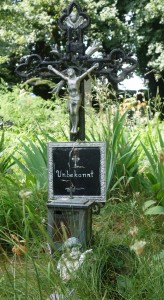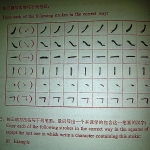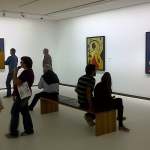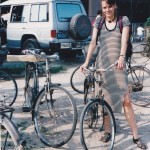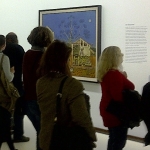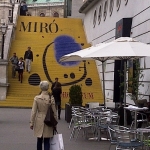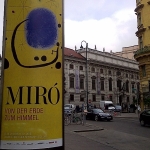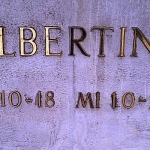Just as only a lover can reveal to a man what life means to him and develop its innermost significance… – Austrian writer Hermann Bahr, 1901, in his “Speech on Klimt” describing Klimt’s artwork.
Gearing up for Vienna’s 2015 LifeBall
 “Dress – good buy. Worn once. Wedding.” The taxi driver gave me a thumbs up and pocketed my Euros. One thing was sure, he was happy to see that thing go.
“Dress – good buy. Worn once. Wedding.” The taxi driver gave me a thumbs up and pocketed my Euros. One thing was sure, he was happy to see that thing go.
Second sure thing, if gowns could talk, this one would have tales to tell because it was going to the Lifeball. With me!
This year’s theme? GOLD – VER SACRUM ala Austrian artist, Gustav Klimt.
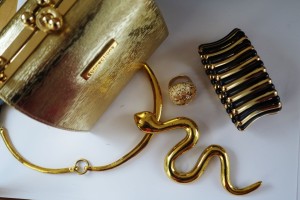
Gold Accessories for Lifeball
Klimt! The name “…intimately associated in the art-lover’s mind with sensuous lines, erotic and beautiful women, and decorative golden detail.” (Essential Klimt)
After the confirmation that I had accomplished the next-to-impossible task of securing a ticket, I moved into action mode. That evening I charged head first into Willhaben’s “Abendkleid” collection, scouring countless computer screens and hundreds of gowns. Finally, in the wee hours of the morning, my weary eyes in blurred determination spotted it like a fata morgana on a distant horizon — a flowing toga-looking dress bearing a bold gold sash and dotted with gold spheres destined for Gustav’s magic.
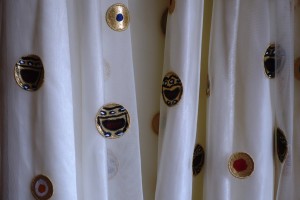
Close of Gown
Next stop, basement of Libro in a hunt for fabric paints (don’t kids do crafts anymore?).
A kitchen table, a bottle of nail polish remover, 99 cent paintbrushes and a Klimt coffeetable book of art I had scored a few years ago for half price at Borders in North Carolina and I was set. I am no artist, but the lights in Vienna’s City Hall were bound to be forgiving. Or the alcohol flowing. Or both. Let’s face it, by midnight, all Cinderellas will have hurried home and every man, woman and Conchita is stunning in any costume.
Contrary to other Vienna balls, come 1 am at the Lifeball, it’s not just the ladies kicking off their heels to jam in their stockings, it’s the guys too. In fact, the entire night, you’re getting sympathetic nods, as they too adjust their mascara, dab some clear nail polish on the run in their ‘hose, and duck into a corner to readjust their bra straps.
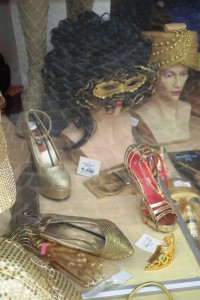
Gold Glam at Vienna’s Faschingsprinz – perfect of Lifeball accessories
“Hmm Hmm Hmmm giiirl! Where did you get such a sassy hair feather? That so accentuates the azure in that gown!” OK. Maybe the German version of that. But you get the idea. And hey! Maybe not. Because the Lifeball is without bounds and without borders. Folks are from anywhere and everywhere. And you won’t know if they are black, white, grey, brown, yellow or polka-dotted green. Speak German, English or Swahili. You also won’t know if they are homosexuals, heterosexuals, transsexuals, asexuals or what-ever. Are they male, female, neither or both? You won’t know. Because no one cares. Everyone is there to have fun, party, celebrate and raise money for a good cause. So get with the program!
Amongst this crowd, if you don’t want to blend into the background like a sparrow in a parade of peacocks, you better go for the gold and accessorize.
Fortunately, I live in the district with probably the very best shop in town for Lifeball needs – Faschingsprinz. Don’t judge this shop by its website. They seem to have last updated their important events list in 2010, but I’m sure that’s just because they’re too busy uniting creative customers with their artistic needs. No idea where to start with your Lifeball outfit? Go there. And if you’re tempted by those sparkling red no-place-like home heels, go for it. They’re bound to match someone’s leather outfit.
Armed with leis of golden flowers and sparkly Egyptian style eye make up damning me to hours of mirror time, I headed home to pimp up my parade.

Lifeball 2014
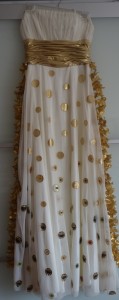
Full Gown for Lifeball
By midnight, pleased my gown project didn’t end in disaster (I have a low success threshold when it comes to creative projects), I was sleep-deprived enough to convince myself that the smock-donning man who was still inspiring multitudes with his beautiful works of art almost a hundred years after his death would have forgiven my attempt to emulate his technique — considering it was for a good cause. But even at that hour I seriously doubted he would have exhibited the thrilled enthusiasm of the taxi driver husband who was so eager to get the gown gone that he offered to perform a home delivery on a Craigslist sale item. A good buy. A very good buy.
Friends have asked why I would want to go to a ball alone. Truth is, I only got one ticket so it wasn’t really a decision. Sure it’d be a blast to go with some friends but if last year’s ball is any indication, I’m not worried.
At the Lifeball there are no sparrows, only peacocks. And I will just sync my step with the suicidal stilettos, shiny heels, sensible sandals and ripped stockings of my fellow Dorothies dreaming of a better place somewhere over the rainbow. That in Vienna, year for year, exists for an entire amazing night. Because beyond the gold, flash, and pizazz is a celebration of “life’s innermost significance” – what distinguishes but unites us. No matter color, creed or sexual orientation. Everyone coming together in a night of awesomeness to fight HIV and AIDs and celebrate life.

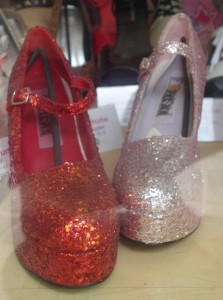
Shoes from Faschingsprinz high and sparkly enough to transport anyone over a rainbow
And I’m ready. Ready to Lifeball.
And maybe get a selfie with Conchita Wurst!
KC’s 2014 Lifeball Good Times and Memories: Celebrating Life in the Garden of Earthly Delights
Vienna Lifeball: Vienna’s City Hall (Rathaus)
Saturday, May 16, 2015
Ball Opening: 9:30 pm
Entrances: Open as of 7:30 pm
The Vienna Ringstrasse will be closed Saturday evening from Schwarzenbergplatz to Schottentor from 6 pm – 11:30 pm.
Don’t have a ball ticket?
Come to the Rathaus (U2 Schottentor or Rathaus) and admire the costumes as ball guests enter the ball parading down the red carpet to the Vienna City Hall.
Want a preview of what’s to come? Check out the Lifeball Style Bible – Klimt’s paintings staged with live models – a feast for the eyes! No wonder the man caused a ruckus when he opted to stop painting the cherubs and go for something a bit more modern – over 100 years ago!










